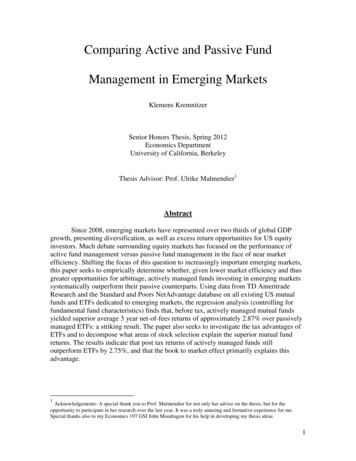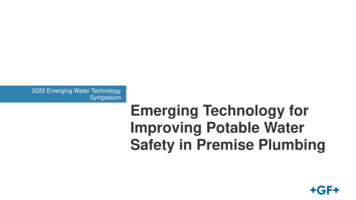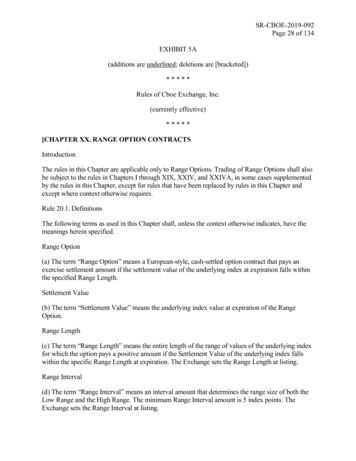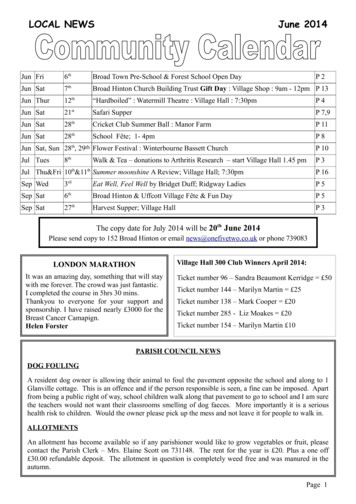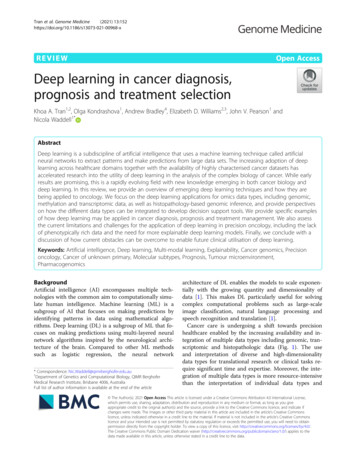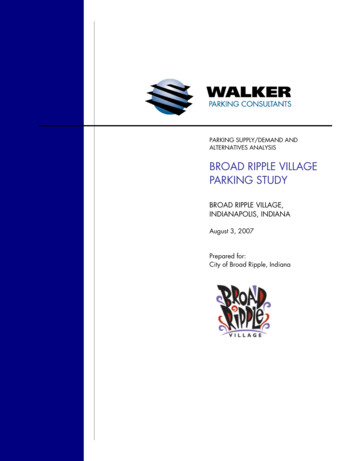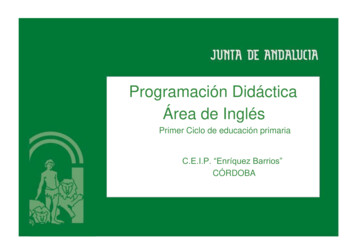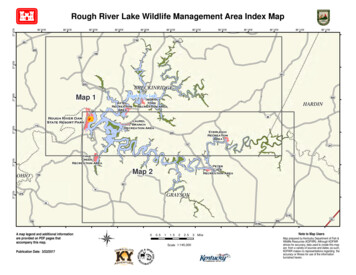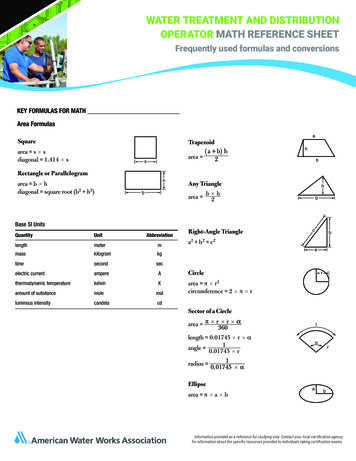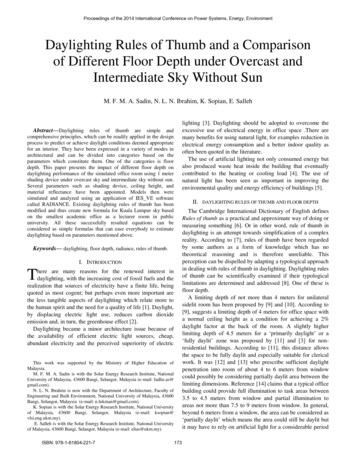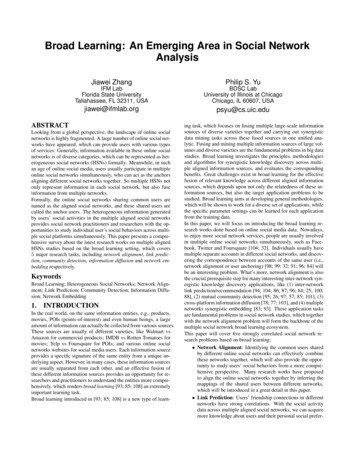
Transcription
Broad Learning: An Emerging Area in Social NetworkAnalysisJiawei ZhangPhilip S. YuIFM LabFlorida State UniversityTallahassee, FL 32311, USABDSC LabUniversity of Illinois at ChicagoChicago, IL 60607, USAjiawei@ifmlab.orgpsyu@cs.uic.eduABSTRACTLooking from a global perspective, the landscape of online socialnetworks is highly fragmented. A large number of online social networks have appeared, which can provide users with various typesof services. Generally, information available in these online socialnetworks is of diverse categories, which can be represented as heterogeneous social networks (HSNs) formally. Meanwhile, in suchan age of online social media, users usually participate in multipleonline social networks simultaneously, who can act as the anchorsaligning different social networks together. So multiple HSNs notonly represent information in each social network, but also fuseinformation from multiple networks.Formally, the online social networks sharing common users arenamed as the aligned social networks, and these shared users arecalled the anchor users. The heterogeneous information generatedby users’ social activities in the multiple aligned social networksprovides social network practitioners and researchers with the opportunities to study individual user’s social behaviors across multiple social platforms simultaneously. This paper presents a comprehensive survey about the latest research works on multiple alignedHSNs studies based on the broad learning setting, which covers5 major research tasks, including network alignment, link prediction, community detection, information diffusion and network embedding respectively.KeywordsBroad Learning; Heterogeneous Social Networks; Network Alignment; Link Prediction; Community Detection; Information Diffusion; Network Embedding1.INTRODUCTIONIn the real world, on the same information entities, e.g., products,movies, POIs (points-of-interest) and even human beings, a largeamount of information can actually be collected from various sources.These sources are usually of different varieties, like Walmart vsAmazon for commercial products; IMDB vs Rotten Tomatoes formovies; Yelp vs Foursquare for POIs; and various online socialnetworks websites for social media users. Each information sourceprovides a specific signature of the same entity from a unique underlying aspect. However, in many cases, these information sourcesare usually separated from each other, and an effective fusion ofthese different information sources provides an opportunity for researchers and practitioners to understand the entities more comprehensively, which renders broad learning [93; 85; 108] an extremelyimportant learning task.Broad learning introduced in [93; 85; 108] is a new type of learn-ing task, which focuses on fusing multiple large-scale informationsources of diverse varieties together and carrying out synergisticdata mining tasks across these fused sources in one unified analytic. Fusing and mining multiple information sources of large volumes and diverse varieties are the fundamental problems in big datastudies. Broad learning investigates the principles, methodologiesand algorithms for synergistic knowledge discovery across multiple aligned information sources, and evaluates the correspondingbenefits. Great challenges exist in broad learning for the effectivefusion of relevant knowledge across different aligned informationsources, which depends upon not only the relatedness of these information sources, but also the target application problems to bestudied. Broad learning aims at developing general methodologies,which will be shown to work for a diverse set of applications, whilethe specific parameter settings can be learned for each applicationfrom the training data.In this paper, we will focus on introducing the broad learning research works done based on online social media data. Nowadays,to enjoy more social network services, people are usually involvedin multiple online social networks simultaneously, such as Facebook, Twitter and Foursquare [104; 32]. Individuals usually havemultiple separate accounts in different social networks, and discovering the correspondence between accounts of the same user (i.e.,network alignment or user anchoring) [98; 99; 32; 91; 96; 84] willbe an interesting problem. What’s more, network alignment is alsothe crucial prerequisite step for many interesting inter-network synergistic knowledge discovery applications, like (1) inter-networklink prediction/recommendation [94; 104; 86; 87; 96; 84; 25; 100;88], (2) mutual community detection [95; 26; 97; 57; 85; 101], (3)cross-platform information diffusion [78; 77; 103], and (4) multiplenetworks synergistic embedding [83; 93]. These application tasksare fundamental problems in social network studies, which togetherwith the network alignment problem will form the backbone of themultiple social network broad learning ecosystem.This paper will cover five strongly correlated social network research problems based on broad learning: Network Alignment: Identifying the common users sharedby different online social networks can effectively combinethese networks together, which will also provide the opportunity to study users’ social behaviors from a more comprehensive perspective. Many research works have proposedto align the online social networks together by inferring themappings of the shared users between different networks,which will be introduced in a great detail in this paper. Link Prediction: Users’ friendship connections in differentnetworks have strong correlations. With the social activitydata across multiple aligned social networks, we can acquiremore knowledge about users and their personal social prefer-
ences. We will introduce the existing research works on thesocial link prediction problem across multiple aligned socialsites simultaneously. Community Detection: Information available across multiple aligned social networks provides more complete signalsrevealing the social communities formed by people in the realworld. We will introduce the existing works on communitydetection with knowledge fused from multiple aligned heterogeneous social networks as the third task. Information Diffusion: The formulation of multiple alignedheterogeneous social networks provides researchers with theopportunity to study the information diffusion process acrossdifferent social sites. The latest research papers on crossnetwork information diffusion will be illustrated as well. Network Embedding: Information from other aligned networks can help refine the feature representations of users effectively. In recent years, some research papers introducethe synergistic network embedding across aligned social networks, where knowledge from other external networks canbe effectively utilized in representation learning tasks.The remainder parts of this paper will be organized as follows. Wewill first provide the basic terminology definitions in Section 2.Via the anchor links, we will introduce the inter-network meta pathconcept in Section 3, which will be used in the following sections.The network alignment research papers will be introduced in Section 4. Inter-network link prediction and friend recommendationwill be talked about in Section 5. A detailed review about crossnetwork community detection will be provided in Section 6. Broadlearning based information diffusion is introduced in Section 7 andnetwork embedding works are available in Section 8. Finally, wewill illustrate several potential future development directions aboutbroad learning and conclude this paper in Section 9.2.TERMINOLOGY DEFINITIONOnline social networks (OSNs) denote the online platforms whichallow people to build social connections with other people, whoshare similar personal or career interests, backgrounds, and real-lifeconnections. Online social networking sites vary greatly and eachcategory of online social networks can provide a specific type offeatured services. To enjoy different kinds of social networks services simultaneously, users nowadays are usually involved in manyof these online social networks aforementioned at the same time,in each of which they will form separate social connections andgenerate a large amount of social information.Formally, the online social networks can be represented as graphs.Besides the users, there usually exist many other types of information entities, like posts, photos, videos and comments, generated byusers’ online social activities. Information entities in online socialnetworks are extensively connected, and the connections amongdifferent types of nodes usually have different physical meanings.The diverse nodes and connections render the online social networks a very complex graph structure. Meanwhile, depending onthe categories of information entities and connections involved, theonline social networks can be divided into different types, like homogeneous network, bipartite network and heterogeneous network.To model the phenomenon that users are involved multiple networks, a new concept called “multiple aligned heterogeneous socialnetworks” [104; 32] has been proposed in recent years.For the networks with simple structures, like the homogeneous networks merely involving users and friendship links, the social patterns in them are usually easy to study. However, for the networks with complex structures, like the heterogeneous networks,the nodes can be connected by different types of link, which willhave totally different physical meanings. One general techniquefor heterogeneous network studies is “meta path” [65; 104], whichspecifically depicts certain link-sequence structures connecting nodedefined based on the network schema. The meta path concept canalso be extended to the multiple aligned social network scenario aswell, which can connect the node across different social networks.Given a network G (V, E), we can represent the set of node andlink types involved in the network as sets N and R respectively.Based on such information, the social network concept can be formally defined based on the graph concept by adding the mappingsindicating the node and link type information.D EFINITION 1. (Social Networks): Formally, a heterogeneoussocial network can be represented as G (V, E, φ, ψ), where V,E are the sets of nodes and links in the network, and mappingsφ : V N , ψ : E R project the nodes and links to theirspecific types respectively. In many cases, the mappings φ, ψ areomitted assuming that the node and link types are known by default.In the following parts of this paper, depending on the categories ofinformation involved in the online social networks, we propose tocategorize the online social networks into three groups: homogeneous social networks, heterogeneous social networks and alignedheterogeneous social networks.2.1Homogeneous Social NetworkD EFINITION 2. (Homogeneous Social Network): For a onlinesocial network G, if there exists one single type of nodes and linksin the network (i.e., N R 1), then the network is called ahomogeneous social network.Given a homogeneous social network G (V, E) with user setV and social relationship set E, depending on whether the linksin G are directed or undirected, the social link can denote eitherthe follow links or friendship links among individuals. Given anindividual user u V in an undirected friendship social network,the set of users connected to u can be represented as the friendsof user u in the network G, denoted as Γ(u) V {v v V (u, v) E}. The number of friends that user u has in thenetwork is also called the degree of node u, i.e., Γ(u) .Meanwhile, in a directed network G, the set individuals followedby u (i.e., Γout (u) {v v V (u, v) E}) are called theset of followees of u; and the set of individuals that follow u (i.e.,Γout (u) {v v V (v, u) E}) are called the set of followersof u. The number of users who follow u is called the in-degree of u,and the number of users followed by u is called the out-degree of uin the network. For the users with large out-degrees, they are calledthe hubs [31] in the network; while those with large in-degrees,they are called the authorities [31] in the network.2.2Heterogeneous Social NetworkD EFINITION 3. (Heterogeneous Social Network): For an online social network G, if there exists multiple types of nodes orlinks in the network (i.e., N 1, or R 1), then the networkis called a heterogeneous social network.Most of the online networks in the real world may contain verycomplex information involving multiple types of nodes and connections. For instance, in the social networks to be studied in thefollowing part, they may involve users, posts, check-ins, words andtimestamps, as well as the friendship links, write links and containlinks among these nodes. Formally, such an online social networkcan be defined as G (V, E), where V denotes the set of nodesand E represents the set of links in G. The node set V can be divided into several subsets V U P L T W involving
the user nodes, post nodes, location nodes, word nodes and timestamp nodes respectively. The link set E can be divided into severalsubsets as well, E Eu,u Eu,p Ep,l Ep,w Ep,t , containingthe links among users, the links between users and posts, and thoseconnecting posts with location checkins, words, and timestamps.In the heterogeneous social networks, each node can be connectedwith a set of nodes belonging to different categories via varioustype of connections. For example, given a user u U, the set ofuser node incident to u via the friend links can be represented as theonline friends of u, denoted as set {v v U, (u, v) Eu,u }; theset of post node incident to u via the write links can be representedas the posts written by u, denoted as set {w w P, (u, w) Eu,p }. The location check-in nodes, word nodes and timestampnodes are not directly connected to the user node, while via the postnodes, we can also obtain the set of locations/words/timestampsthat are visited/used/active-at by user u in the network. Such indirect connections can be described more clearly by the meta pathconcept more clearly in Section 3.Network schema provides a meta level description of networks.Meanwhile, if a network G can be outlined by the network schemaSG , G is also called a network instance of the network schema.For a given node u V, we can represent its corresponding nodetype as φ(u) N N , and call u is an instance of node type N ,which can also be denoted as u N for simplicity. Similarly, fora link (u, v), we can denotes its link type as ψ((u, v)) R R,or (u, v) R for short. The inverse relation R 1 denotes a newlink type with reversed direction. Generally, R is not equal to R 1 ,unless R is symmetric.2.312 Nk , where Ni N , i N1 N2 · · · Nk 1 {1, 2, · · · , k} and Ri R, i {1, 2, · · · , k 1}.Aligned Heterogeneous Social NetworksD EFINITION 4. (Multiple Aligned Heterogeneous Networks): Formally, the multiple aligned heterogeneous networks involving nnetworks can be defined as G ((G(1) , G(2) , · · · , G(n) ),(A(1,2) , A(1,3) , · · · , A(n 1,n) )), where G(1) , G(2) , · · · , G(n) denote these n heterogeneous social networks and the sets A(1,2) ,A(1,3) , · · · , A(n 1,n) represent the undirected anchor links aligning these networks respectively.Anchor links actually refer to the mappings of information entitiesshared across different sources, which correspond to the the sameinformation entity in the real world, e.g., users in online social networks, authors in different bibliographic networks, and movies inthe movie knowledge libraries.D EFINITION 5. (Anchor Link): Given two heterogeneous networks G(i) and G(j) which share some common information entities, the set of anchor links connecting G(i) and G(j) can be(j)(i)(j)(i)represented as set A(i,j) {(um , un ) um V (i) un (i)(j)V (j) um , un denote the same information entity}.The anchor links depict a transitive relationship among the information entities across different networks. Given 3 information en(k)(j)(i)tities um , un , uo from networks G(i) , G(j) and G(k) respec(i)(j)(j)(k)tively, if um , un are connected by an anchor link and un , uo(i)(k)are connected by another anchor link, then the user pair um , uowill be connected by an anchor link by default. For more detaileddefinitions about other related terms, like anchor users, non-anchorusers, full alignment, partial alignment and non-alignment, pleaserefer to [104].3.META PATHTo deal with the social networks, especially the heterogeneous social networks, a very useful technique is meta paths [65; 104]. Metapath is a concept defined based on the network schema, outliningthe connections among nodes belonging to different categories. Forthe nodes which are not directly connected, their relationships canbe depicted with the meta path concept. In this part, we will definethe meta path concept, and introduce a set of meta paths within andacross real-world heterogeneous social networks respectively.3.1Network SchemaGiven a network G (V, E), we can define its network schema todescribe the categories of nodes and links involved in G.3.2Meta Path in Heterogeneous Social NetworksMeta path is a concept defined based on the network schema denoting the correlation of nodes based on the heterogeneous information (i.e., different types of nodes and links) in the networks.D EFINITION 7. (Meta Path): A meta path P defined based onthe network schema SG (N , R) can be represented as P RRk 1RFurthermore, depending on the categories of node and link typesinvolved in the meta path, we can specify the meta path conceptinto several more refined groups, like homogeneous meta path andheterogeneous meta path, or social meta path and other meta paths.D EFINITION 8. (Homogeneous/Heterogeneous Meta Path): LetRk 1RR21· · · Nk 1 Nk denote a meta pathN2 P N1 defined based on the network schema SG (N , R). If all thenode types and link types involved in P are of the same category,P is called a homogeneous meta path; otherwise, P is called aheterogeneous meta path.The meta paths can connect any kinds of node type pairs, andspecifically, for the meta paths starting and ending with the usernode types, those meta paths are called the social meta paths.RR12D EFINITION 9. (Social Meta Path): Let P N1 N2 Rk 1 Nk denote a meta path defined based on network· · · Nk 1 schema SG (N , R). If the starting and ending node types N1and Nk are both the user node type, P is called a social meta path.Users are usually the focus in social network studies, and the socialmeta paths are frequently used in both research and real-world applications and services. The number of path segments in the metapath is called the meta path length. For instance, the length of metaRRk 1R12N2 · · · Nk 1 Nk is k 1. Metapath P N1 paths can also been concatenated together with the meta path composition operator.D EFINITION 10. (Meta Path Composition): Meta paths P 1 R11Rk 1R1R21211N11 N21 · · · Nk 1 Nk1 , and P 2 N12 2Rl 1R222N22 Nl1 can be concatenated together to· · · Nl 11Rk 1R11form a longer meta path P P 1 P 2 N11 ··· R22Rl 1R2122Nk1 N22 · · · Nl 1 Nl1 , if the ending node type ofP 1 is the same as the starting node type of P 2 , i.e., Nk1 N12 . Thenew composed meta path is of length k l 2.RRRk 112Meta path P N1 N2 · · · Nk 1 Nk can alsoRD EFINITION 6. (Network Schama): Formally, the schema ofnetwork G can be denoted as SG (N , R), where N and Rare the sets of node type and link type in the network respectively.1been treated as the concatenation of simple meta paths N1 N2 ,R2Rk 1N2 N3 , · · · , Nk 1 Nk , which can be represented asP R1 R2 · · · Rk 1 Rk .
3.3Meta Path across Aligned HeterogeneousSocial NetworksBesides the meta paths within one single heterogeneous network,the meta paths can also be defined across multiple aligned heterogeneous networks via the anchor meta paths.D EFINITION 11. (Anchor Meta Path): Let G(1) and G(2) betwo heterogeneous networks sharing the common anchor information entity of types N (1) N (1) and N (2) N (2) respectively.The anchor meta path between the schemas of networks G(1) andAnchorG(2) can be represented as Φ N (1) N (2) of length 1.The anchor meta path is the simplest meta path across aligned networks, and a set of inter-network meta paths can be defined basedon the intra-network meta paths and the anchor meta path.D EFINITION 12. (Inter-Network Meta Path): A meta path Ψ RRRk 112N1 N2 · · · Nk 1 Nk is called an inter-networkmeta path between networks G(1) and G(2) iff m {1, 2, · · · , k 1}, Rm Anchor.The inter-network meta paths can be viewed as a composition ofintra-network meta paths and the anchor meta path via the usernode types. An inter-network meta path can be a meta path starting with an anchor meta path followed by the intra-network metapaths, or those with anchor meta paths in the middle. Here, we introduce several categories inter-network meta paths involving theanchor meta paths at different positions as defined in [104]: Ψ(G(1) , G(2) ) Φ(G(1) , G(2) ), which denotes the simplestinter-network meta path composed of the anchor meta pathonly between networks G(1) and G(2) . Ψ(G(1) , G(2) ) Φ(G(1) , G(2) ) P (G(2) ), which denotesthe inter-network meta path starting with an anchor metapath and followed by the intra-network social meta path innetwork G(2) . Ψ(G(1) , G(2) ) P (G(1) ) Φ(G(1) , G(2) ), which denotesthe inter-network meta path starting with the intra-networksocial meta path in network G(1) followed by an anchormeta path between networks G(1) and G(2) . Ψ(G(1) , G(2) ) P (G(1) ) Φ(G(1) , G(2) ) P (G(2) ), whichdenotes the inter-network meta path starting and ending withthe intra-network social meta path in networks G(1) and G(2)respectively connected by an anchor meta path between networks G(1) and G(2) .These meta path concepts introduced in this section will be widelyused in various social network learning tasks to be introduced later.4.NETWORK ALIGNMENTNetwork alignment is an important research problem and dozens ofpapers have been published on this topic in the past decades. Depending on specific disciplines, the studied networks can be socialnetworks in data mining [98; 99; 32; 91; 96; 84] protein-proteininteraction (PPI) networks and gene regulatory networks in bioinformatics [27; 60; 38; 61], chemical compound in chemistry [63],data schemas in data warehouse [45], ontology in web semantics[14], graph matching in combinatorial mathematics [44], as well asgraphs in computer vision [11; 6].In bioinformatics, the network alignment problem aims at predicting the best mapping between two biological networks based onthe similarity of the molecules and their interaction patterns. Bystudying the cross-species variations of biological networks, network alignment problem can be applied to predict conserved functional modules [58] and infer the functions of proteins [50]. Graemlin [17] conducts pairwise network alignment by maximizing anobjective function based on a set of learned parameters. Someworks have been done on aligning multiple network in bioinformatics. IsoRank proposed in [62] can align multiple networks greedilybased on the pairwise node similarity scores calculated with spectral graph theory. IsoRankN [38] further extends IsoRank model byexploiting a spectral clustering scheme in the framework.In recent years, with rapid development of online social networks,researchers’ attention starts to shift to the alignment of social networks. Enlightened by the homogeneous network alignment methodin [70], Koutra et al. [35] propose to align two bipartite graphs witha fast alignment algorithm. Zafarani et al. [76] propose to matchusers across social networks based on various node attributes, e.g.,username, typing patterns and language patterns etc. Kong et al.formulate the heterogeneous social network alignment problem asan anchor link prediction problem. A two-step supervised networkalignment method MNA is proposed in [32] to infer potential anchor links across networks with heterogeneous information in thenetworks. However, social networks in the real world are mostlypartially aligned actually and lots of users are not anchor users.Zhang et al. have proposed a partial network alignment methodspecifically in [91].In the social network alignment model building, the anchor linksare very expensive to label manually, and achieving a large-sizedanchor link training set can be extremely challenging. In [96],Zhang et al. propose to study the network alignment problem basedon the PU (Positive and Unlabeled) learning setting instead, wherethe model is built based on a small amount of positive set and alarge unlabeled set. Furthermore, in the case when no training datais available, via inferring the potential anchor user mappings acrossnetworks, Zhang et al. have introduced an unsupervised networkalignment models for multiple (more than 2) social networks in[98] and an unsupervised network concurrent alignment model viamultiple shared information entities simultaneously in [99].Next, we will introduce the social network alignment methods basedon the pairwise and global alignment settings respectively.4.1Pairwise Unsupervised Network AlignmentIn this part, we will study the network alignment problem basedon unsupervised learning setting, which needs no labeled trainingdata. Given two heterogeneous online social networks, which canbe represented as G(1) (V (1) , E (1) ) and G(2) (V (2) , E (2) )respectively, the unsupervised network alignment problem aims atinferring the anchor links between networks G(1) and G(2) . LetU (1) V (1) and U (2) V (2) be the user set in these two networksrespectively, we can represent the set of potential anchor links between networks G(1) and G(2) as A U (1) U (2) . In the unsupervised network alignment problem, among all the potential anchorlinks in set A, we want to infer which one exists in the real world.Given two homogeneous networks G(1) and G(2) , mapping thenodes between them is an extremely challenging task, which is alsocalled the graph isomorphism problem [54; 18]. The graph isomorphism has been shown to be NP, but it is still not known whether italso belongs to P or NP-complete yet. So far, no efficient algorithmexists that can address the problem in polynomial time. In thispart, we will introduce several heuristics based methods to solvethe pairwise homogeneous network alignment problem.4.1.1Heuristics based Network Alignment ModelThe information generated by users’ online social activities canindicate their personal characteristics. The features introduced inthe previous subsection, like ECN, EJC and EAA based on socialconnection information, similarity/distance measures based on location checkin information, temporal activity closeness, and textword usage similarity can all be used as the predictors indicating
whether the cross-network user pairs are the same user or not. Besides these measures, in this part, we will introduce a category newmeasures, Relative Centrality Difference (RCD), which can also beapplied to solve the unsupervised network alignment problem.The centrality concept can denote the importance of users in theonline social networks. Here, we assume that important users inone social network (like celebrities, movie stars and politicians)will be important as well in other networks. Based on such anassumption, the centrality of users in different networks can be animportant signal for inferring the anchor links across networks.If the networks are weighted, and all the intra-network connections(1)(1)(1)(1)like (ui , um ) will be associated with a weight w(ui , um ),(1)(2)we can represented the reliability measure of r(ui , uj ) in theweighted network as(1)r(ui(2), ujXX) (1)w(ui(2), uj(1)(2))r(um , un ),(6)(2)(1)(2)(1))) un Γ(uum Γ(uiiwhere the weight term(1)w(ui(2), uj)(7)(1)(1)w(ui(2)(2), um )w(uj , un ). P(1)(1) P(2)(2)(1) w(ui , up )(2) w(uj , uq(1)(2)))up Γ(uuq Γ(uiiD EFINITION 13. (Relative Centrality Difference): Given two(1)(2)(1)users ui , uj from networks G(1) and G(2) respectively, let C(ui )(8)(2)and C(uj ) denote the centrality scores of the users, we can definethe relative centrality difference (RCD) as (1)(2)RCD(ui , uj ) 1 1(1)(2) C(ui ) C(uj ) .(1)(2)C(ui ) C(uj ) /2(1)Depending on the centrality measures applied, different types ofrelative centrality difference measures can be defined. For instance,if we use node degree as the centrality measure, the relative degreedifference can be represented as (1)(2)RDD(ui , uj ) 1 1(1)(2) D(ui ) D(uj ) (1)(2)D(ui ) D(uj ) /2.(2)Meanwhile, if the PageRank scores of the nodes are used to definetheir centrality, we can represent the relative centrality differencemeasure as 1(1)(2) S(ui ) S(uj ) . 1 (1)(2)S(ui ) S(uj ) /2 (1)(2)RCD(ui , uj )(3)In the above equations, D(u) and S(u) denote the node degree andpage rank score of node u within each network respectively.4.1.2IsoRankModel IsoRank [62] initially proposed to align the biomedical networks, like protein protein interaction (PPI) networks and gene expression networks, can be used to solve the unsupervised socialnetwork alignment problem as well. The IsoRank algorithm hastwo stages. It first associates a score with each possible anchorlinks between nodes of the two networks. For instance, we can(1)(2)denote r(ui , uj ) as the reliability score of an potential anchor(1)(2)link (ui , uj ) between the networks G(1) and G(2) , and all suchscores can be organized into a vector r of length U (1) U (2) .In the second stage of IsoRank, it constructs the mapping for thenetworks by extracting from r.D EFINITION 14. (Reliability Score): The reliability score(1)(2)
umes and diverse varieties are the fundamental problems in big data studies. Broad learning investigates the principles, methodologies . the hubs [31] in the network; while those with large in-degrees, they are called the authorities [31] in the network. 2.2 Heterogeneous Social Network DEFINITION 3. (Heterogeneous Social Network): For an on-
